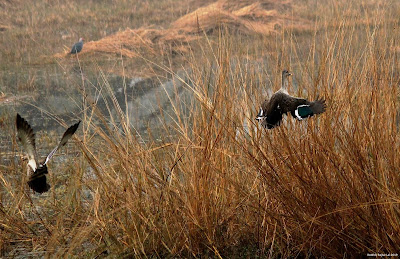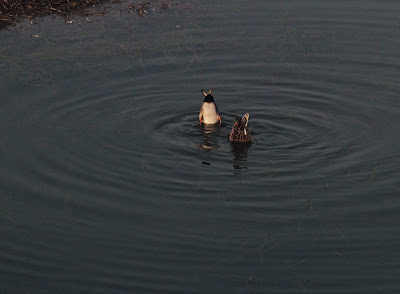This Saturday when I visited the Sultan[ur National Park, I had thought of focusing on birds in flight. For this, I opted for a really fast shutter speed (1/20000) and an aperture of (f-5.6-f-11). Unfortunately, the fog played spoilsport and I ended up with a few rather smudged up snaps that wouldn't pass muster as mug shots of the Loch Ness Monster taken with a black and white film roll! This post is a reminder that light plays a great role in good photography. Unfortunately, the birds in the Sultanpur National Park seem to disappear from the National Park after nine in the morning. It is as if they like to fly away for shopping after having a hearty meal of fish and snails!
I counted myself lucky to be carrying a smaller lens (55-250 mm) which meant that I might be able to scrape through the dim light especially since I had an f 1:4-5.6 lens. There were others who were carrying 600, 1000 mm lenses that would have had a narrower aperture thus requiring more light!
I was lugging a tripod to which I had attached my camera. This in itself made it a bit difficult to pan or swing to get the flying birds within the view. In the end, I opted to swing the camera using the tripod legs, (unopened) as a pivot. I was able to somehow spot a brace of spot-billed ducks make a landing in the water. I have pasted the snap above.
Nothing can beat the gracefulness of birds in flight, especially the lumbering giants like storks and cranes. I had thought of taking a snap of the lone Duckbill in flight that I had spotted a week before, but alas, it seemed to have shifted to another spot!
The Juvenile storks, however, seemed to be plentiful and I decided to turn my attention towards them instead. The Juvenile Painted storks lack the bright colours of the adults. Their beaks appear to be dull and their heads lack the bright orange-red colour of the adults.
But then I was also pleasantly surprised to spot the Black Redstart Bird at the Sultanpur National Park just prior to exiting the park. A rather colourful bird with an attractive colour scheme!
The resident White-throated Kingfisher and the ubiquitous Heron were there as usual, though I would like to add that Kingfishers seem to be aplenty! The shot posted below seemed to have caught the morning rays of the rising sun to its benefit. Photographers call the morning hours as the golden hours because of the warmer tones!
The Grey Heron seemed to be as curious of me as I was of it! Well, it turned a number of times wondering what I was doing paying it so much attention. It even gave me a full-fronted glare!
The Purple Heron stretched its neck out, unmoving so still, that one might mistake it for an unmoving branch. These birds are known to wait patiently for fish to swim into its vicinity before pouncing for it. At this time of the year, the Sultanpur National Park teems with Herons and Egrets of all kinds.























































